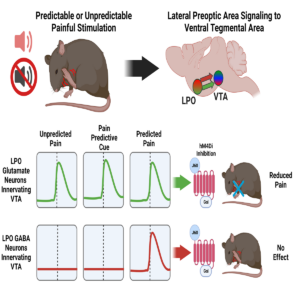 Hot Off the Press – October 24, 2023
Hot Off the Press – October 24, 2023
Published in Cell Reports by David Barker, Shiliang Zhang and Marisela Morales et al. from the NIDA IRP.
Summary
The ventral tegmental area (VTA) has been proposed to play a role in pain, but the brain structures modulating VTA activity in response to painful stimuli remain unclear. Here we demonstrated that the lateral preoptic area (LPO) glutamate neurons relay pain information to the VTA. These LPO-glutamatergic neurons synapsing on VTA neurons respond to painful stimulation, conditioned stimuli predicting pain, and mediate aversion. The pathway from LPO glutamatergic neurons to the VTA represents an unpredicted interface between peripheral painful information and the limbic system.
Publication Information
Lateral preoptic area glutamate neurons relay nociceptive information to the ventral tegmental area Journal Article
In: Cell Rep, vol. 42, no. 9, pp. 113029, 2023, ISSN: 2211-1247.
